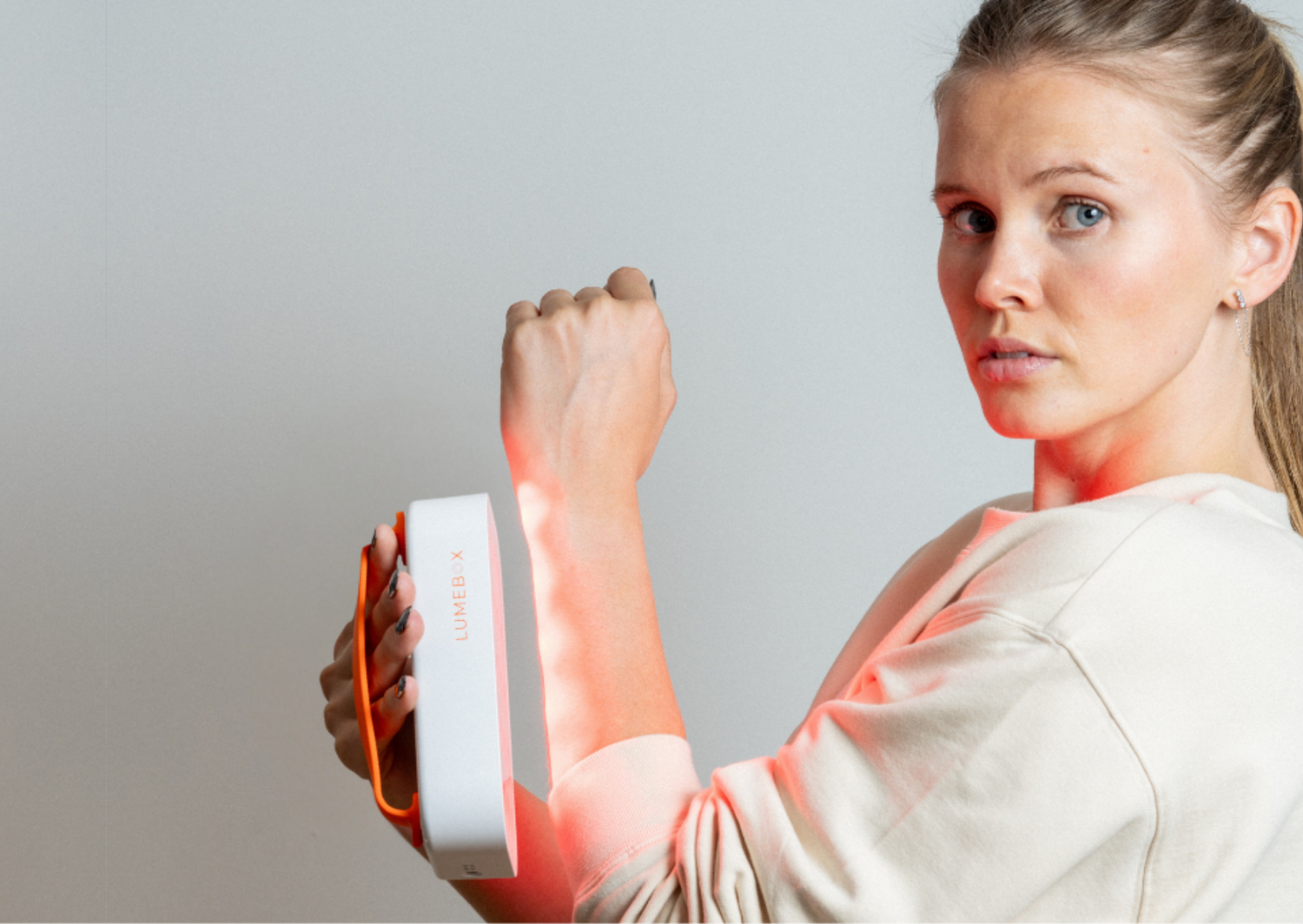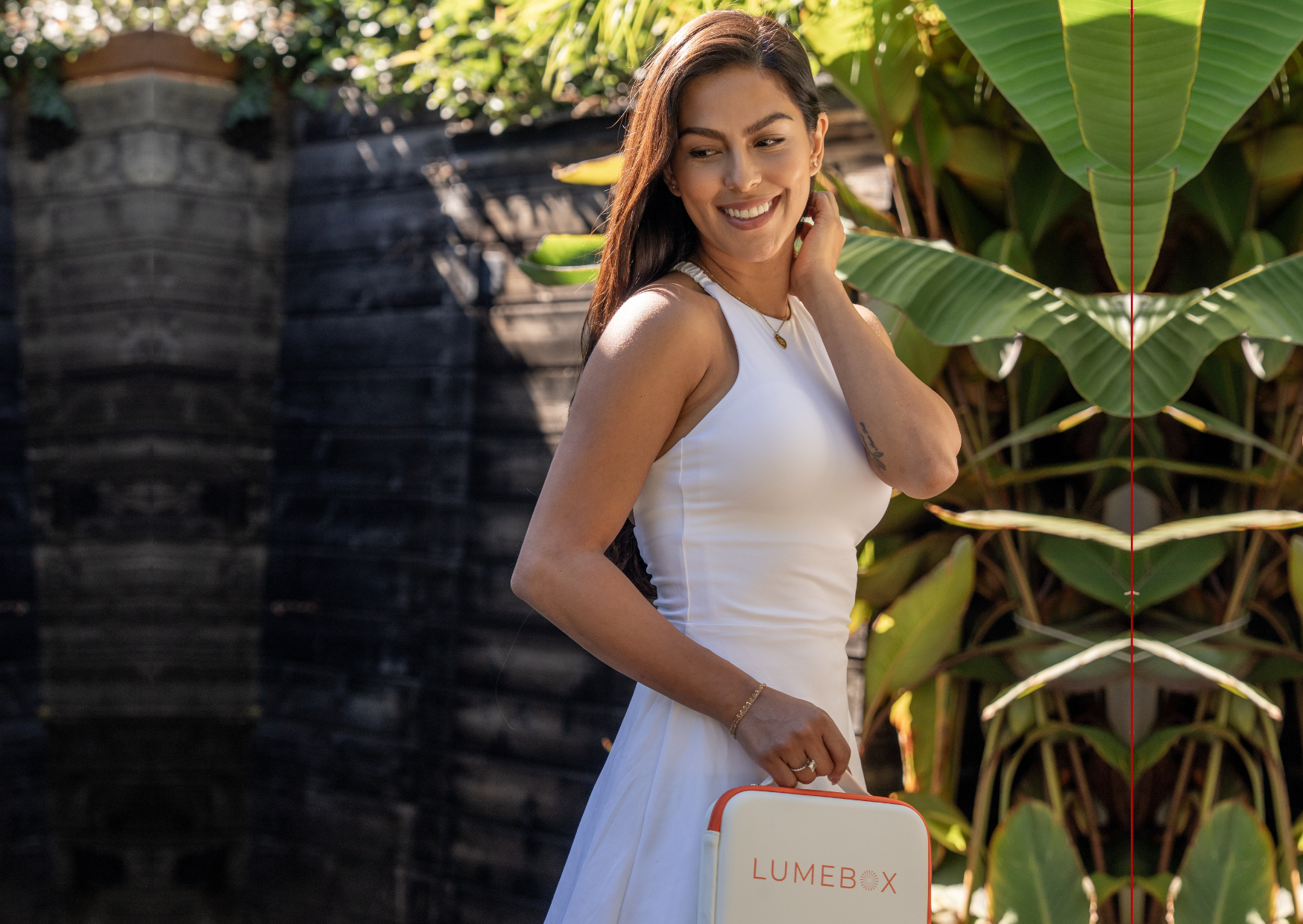If you’ve looked into red light therapy devices, you’ve probably seen brands throwing around big numbers for power output—some boasting sky-high irradiance, others skipping specs altogether.
But here’s the thing: irradiance (aka power output) is what matters. A powerful device lets you fine-tune the intensity of red light therapy you’re receiving by adjusting your distance from the device. The closer you are, the stronger the light—perfect for deeper tissues like muscles and joints, while skin responds best to gentler exposure.
So how do you find the sweet spot for your goals?
Why Distance Changes Red Light Therapy Irradiance
Imagine turning on a flashlight in a dark room—the closer you shine it on a surface, the brighter and more concentrated the light appears.
Irradiance in red light therapy works the same way—the intensity of light reaching your skin depends on how close you are to the source.
Irradiance is the intensity of light that reaches a surface, measured in milliwatts per square centimeter (mW/cm²).
Is High Irradiance Always Better?
Not necessarily.
While power levels matter, they’re most important if you’re treating deeper tissues like muscles or joints. For skin, a moderate irradiance is often more effective than blasting your face with excessive light (because of something called the biphasic dose response, where more isn’t always better).
A higher irradiance is achieved by holding the light closer to the skin, which:
- Allows light to better reach deeper tissues.
-
Reduces treatment time by delivering light more efficiently.
- May cause overexposure if used too intensely or for too long.
How Far Should I Hold My Red Light Therapy Device?
The “ideal” distance for red light therapy isn’t universal—it depends on:
- The irradiance of your device
- The depth of the target tissue
- Individual differences in light absorption
Distance dilutes irradiance. The farther you are from the light source, the lower the intensity. This is why distance matters in red light therapy, as irradiance naturally decreases with increasing distance.
For muscles and joints, keeping your device near the skin ensures that enough light penetrates deep into the tissues.
For skin health, a lower irradiance is optimal, so holding the device farther away (about 6 inches for LUMEBOX) softens the intensity, delivering the optimal irradiance for skin benefits.

This is why red light masks can ONLY be used for the face - they deliver a low irradiance because they sit very close to the skin. Because of this, they aren’t suitable for joints, hair growth, or other tissues that require higher light doses.
With LUMEBOX, you’re in control. Moving it closer increases irradiance for deeper tissues, while positioning it further away lowers irradiance for skin health.
But how much irradiance do you actually need?
What’s the Ideal Irradiance for Muscles & Joints?
Muscles and joints require higher irradiance than the skin because the light needs to penetrate deeper to reach the target tissues. Generally, aiming for an irradiance of 30-150 mW/cm² is recommended to reach below the skin surface [7,8,9,10].
Note: Studies on brain health often use irradiance levels of 200 mW/cm² or higher to support light penetration through the skull. [5]
How Close Should I Hold LUMEBOX for Deeper Tissues?
For joints and muscles, near-infrared mode is ideal for reaching deeper tissues, as it may penetrate further beneath the skin. For best results, hold the device as close to the skin as comfortably possible.
We had LUMEBOX independently tested by SGS. Here’s the irradiance it delivers at 1cm:

What’s The Ideal Irradiance For Skin?
Different tissues require different levels of light intensity.
For example, studies targeting eye health use very low irradiance, as low as 8 mW/cm² [1], due to the delicate nature of eye tissues. This is why we do not currently recommend you use LUMEBOX for eye health unless advised by your eye doctor.
As treatments shift to the skin, the ideal irradiance increases slightly.
Studies have shown that the ideal irradiance for red light therapy in facial skin rejuvenation—supporting skin health and minimizing the appearance of wrinkles and fine lines—centers around 25 mW/cm² [2,3,4] because skin is a surface-level tissue that absorbs light efficiently.
How Close To the Skin Should I Hold LUMEBOX?
We had LUMEBOX independently tested by SGS. At 15 cm, LUMEBOX delivers an irradiance of ~22.5 mW/cm²—ideal for skin.
Here are the numbers:

Will Red Light Therapy Burn My Skin If I Hold It Too Close?
First things first—everyone responds differently to red light therapy. You may have more sensitive skin, or certain conditions or medications that make your skin more reactive to red light, so it’s always best to check with your doctor.
That said, according to this paper by Dr Hamblin [6], the irradiance values that might burn the skin are:
- NIR: 750mw/cm²
- Red: 300mw/cm²
Provided the skin is healthy, you’d usually experience unacceptable heat or pain when the irradiance is too high, serving as a natural warning that the skin may be at risk of burns.
You're unlikely to find many devices on the market that emit higher than 200 mW/cm² for this reason.
The Final Touch: How Long Should I Use Red Light Therapy?
The ideal session length depends on irradiance—how much light your body is absorbing per second. But just because we know the upper safety limits doesn’t mean we should aim for the highest possible dose.
So, to determine how long to use red light therapy, it's important to understand the irradiance you're working with.
Here are some general guidelines based on LUMEBOX’s irradiance levels:
- For skin → At 15 cm (6 inches) away, a 6-minute session delivers a dose within the ideal range.
- For muscles & joints → At 1 cm (close to the skin), a 12-minute session provides the target dose for deeper tissues.
If you're curious about fine-tuning your sessions, check out our detailed guide on calculating the ideal red light dose and find what works best for you!
New to red light therapy? Download our free eBook to help you choose the best device.
Already have a LUMEBOX? Download our 6 time-saving tricks guide!
Medical Disclaimer: The information contained in this blog post is intended for educational purposes only and should not be used as medical advice. Everyone responds to light differently. Testimonials are not a guarantee of the results you or anyone who uses LUMEBOX will get because your success depends entirely on your circumstances, and the studies on red light therapy shared were not specifically performed using LUMEBOX. Please check with your doctor before using red light therapy and do not change your medical treatments or lifestyle without consulting your physician first.
References:
[1] Shinhmar H, Hogg C, Neveu M, Jeffery G. Weeklong improved colour contrasts sensitivity after single 670 nm exposures associated with enhanced mitochondrial function. Sci Rep. 2021 Nov 24;11(1):22872. doi: 10.1038/s41598-021-02311-1. PMID: 34819619; PMCID: PMC8613193.
[2] Couturaud V, Le Fur M, Pelletier M, Granotier F. Reverse skin aging signs by red light photobiomodulation. Skin Res Technol. 2023 Jul;29(7):e13391. doi: 10.1111/srt.13391. PMID: 37522497; PMCID: PMC10311288.
[3] Wunsch A, Matuschka K. A controlled trial to determine the efficacy of red and near-infrared light treatment in patient satisfaction, reduction of fine lines, wrinkles, skin roughness, and intradermal collagen density increase. Photomed Laser Surg. 2014 Feb;32(2):93-100. doi: 10.1089/pho.2013.3616. Epub 2013 Nov 28. PMID: 24286286; PMCID: PMC3926176.
[4] Zein R, Selting W, Hamblin MR. Review of light parameters and photobiomodulation efficacy: dive into complexity. J Biomed Opt. 2018 Dec;23(12):1-17. doi: 10.1117/1.JBO.23.12.120901. PMID: 30550048; PMCID: PMC8355782.
[5] Schiffer, F., Johnston, A. L., Ravichandran, C., Polcari, A., Teicher, M. H., Webb, R. H., & Hamblin, M. R. (2009). Psychological benefits 2 and 4 weeks after a single treatment with near-infrared light to the forehead: A pilot study of 10 patients with major depression and anxiety. Behavioral and Brain Functions, 5(46). https://doi.org/10.1186/1744-9081-5-46
[6] Zein R, Selting W, Hamblin MR. Review of light parameters and photobiomodulation efficacy: dive into complexity. J Biomed Opt. 2018 Dec;23(12):1-17. doi: 10.1117/1.JBO.23.12.120901. PMID: 30550048; PMCID: PMC8355782.
[7] Paolillo FR, Borghi-Silva A, Parizotto NA, Kurachi C, Bagnato VS. New treatment of cellulite with infrared-LED illumination applied during high-intensity treadmill training. J Cosmet Laser Ther. 2011 Aug;13(4):166-71. doi: 10.3109/14764172.2011.594065. PMID: 21740089.
[8] Schiffer, F., Johnston, A.L., Ravichandran, C. et al. Psychological benefits 2 and 4 weeks after a single treatment with near infrared light to the forehead: a pilot study of 10 patients with major depression and anxiety. Behav Brain Funct 5, 46 (2009). https://doi.org/10.1186/1744-9081-5-46
[9] Foley J, Vasily DB, Bradle J, Rudio C, Calderhead RG (2016) 830 nm light-emitting diode (led) phototherapy significantly reduced return-to-play in injured university athletes: a pilot study. Laser Ther 25(1):35–42.https://doi.org/10.5978/islsm.16-OR-03xf
[10] Mak MC, Cheing GL. Immediate effects of monochromatic infrared energy on microcirculation in healthy subjects. Photomed Laser Surg. 2012 Apr;30(4):193-9. doi: 10.1089/pho.2011.3012. Epub 2012 Jan 5. PMID: 22220935.




